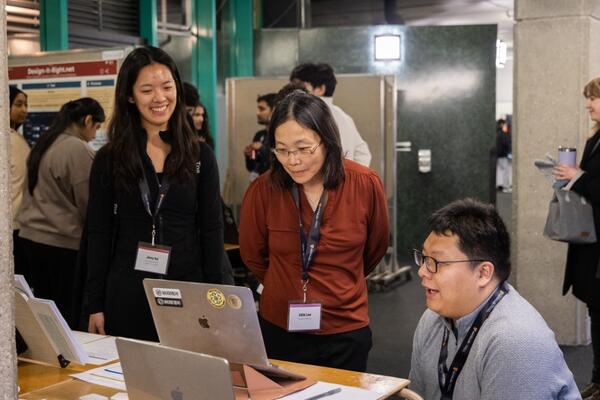
Technovation program inspires girls to explore computing
Instructional course empowers young girls to code under the guidance of female mentors

Instructional course empowers young girls to code under the guidance of female mentors
By Joe Petrik School of Computer ScienceBefore the boom of our digital age, the task of solving complex mathematical calculations in pencil and chalk was done largely by women. Later, as the first computers started to emerge, it was women who continued to serve as the world’s first programmers.
But today, only 7 per cent of tech startups are led by women, and only 20 per cent of the technical workforce is women. While some gains have been made (e.g., undergraduate female enrolments in the Faculty of Mathematics Computer Sciences Program have doubled in the last 10 years), females are still highly underrepresented in the computer science. In fact, only one in five computer science undergraduates at the University of Waterloo are women — a shocking stat that is mirrored at many other universities.
“The gender gap in computer science has many causes, some historical, others more recent,” said Professor and Director of Women in Computer Science Jo Atlee. “The gap starts well before students begin university. It would be wonderful if we had K-12 education in computing, just like we do for English and math, but computer science often isn’t offered, let alone, mandatory.”
To combat this problem, Atlee hopes to create a supportive environment through Technovation Waterloo, a 12-week online and in-class program that gives teams of girls from Grades 5 to 12 an opportunity to learn and experience theoretical and practical computing skills. The final challenge will see teams of 5 develop a mobile app that addresses an issue affecting society (with an emphasis on Waterloo’s local community). The themes are UN-focused, with areas like health, education, peace, poverty, equality and the environment being addressed. In May, Google Waterloo will host a pitching competition, with the winning team taking home a monetary prize and bragging rights as it moves on to the the global competition. The hope is to encourage girls to pursue coding, build businesses and finesse their pitching skills.

It’s the sort of opportunity Honours Computer Science and Combinatorics & Optimization undergrad Anna Lorimer wish had existed when she was growing up.
“My high school didn’t have computer science courses at all, but I was very much a math whiz, so I applied to undergrad math programs,” said Lorimer. “I didn’t take computer science until I started university — a theme common among girls. Lots of boys are exposed to computers at a much younger age than girls are. And a lot of young women applying to university simply don’t know that computer science is an option. This limits the number of women entering the field.”
Seeing it first-hand, Lorimer notes that the consequences of a male-dominated discipline extend beyond lost career opportunities for women, with repercussions also limiting ideas and industry insight.
“At a basic level, the more diverse the people you employ, the better the ideas, the better the field, the better the product.”
60 mentors (including 17 students from the University of Waterloo) will be helping deliver the program, while another 120 students in the Waterloo Region have already signed up to participate. While programming for Technovation Waterloo commenced Sunday, January 14, registration will remain open until Wednesday, March 7.

Read more
Here are the people and events behind some of this year’s most compelling Waterloo stories

Read more
Students showed how AI can enhance education and career development at the Google-UWaterloo Symposium

Read more
A closer look at the University of Waterloo’s beloved network of pedestrian tunnels and bridges
The University of Waterloo acknowledges that much of our work takes place on the traditional territory of the Neutral, Anishinaabeg, and Haudenosaunee peoples. Our main campus is situated on the Haldimand Tract, the land granted to the Six Nations that includes six miles on each side of the Grand River. Our active work toward reconciliation takes place across our campuses through research, learning, teaching, and community building, and is co-ordinated within the Office of Indigenous Relations.